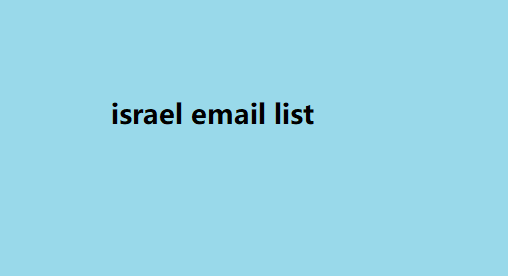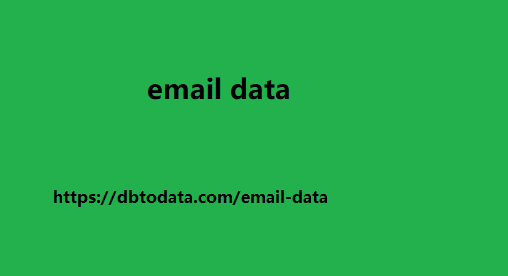Your cart is currently empty!
Tag: israel email list
5 Signs It’s Time to Clean Up Your Email List
A healthy email list is key to running a successful email marketing campaign. Regularly cleaning your email list helps maintain high levels of engagement, improves deliverability, and ensures your efforts aren’t wasted. Neglecting this task can lead to poor results and damage your sender reputation. Let’s explore five signs that it’s time to clean your email list.
Signal 1 # Falling open rates
Open rates are a key metric in email marketing, representing the percentage of email recipients who open a given email compared to the total number of emails delivered. For example, if 1,000 emails are sent and 150 recipients open them, the open rate is 15%. This metric is critical because it is the first indication that the content of your email has captured the recipient’s attention, based largely on the subject line, sender name, and preheader text.
Importance of open rates in email marketing
- Measure Campaign Performance:
Open rates offer a glimpse into the effectiveness of your email’s first impression. A high open rate suggests that recipients find your brand’s emails engaging and relevant enough to take the first step of opening them. Conversely, a declining open rate signals problems. It could mean that your email content, timing, or even your audience’s preferences have changed, making your emails less compelling. - Customer Engagement Indicator:
Open rates provide insight into how well you are maintaining a relationship with your subscribers. A healthy open rate shows that recipients are still engaged with your content. On the other hand, declining open rates can indicate growing disinterest or dissatisfaction among your audience, signaling potential churn or that your subscriber list has become stale or irrelevant. - Report an outdated or stale contact list:
Declining open rates can also suggest that your email list has become stale. Some contacts may no longer use the email addresses they originally provided, while others may have lost interest in your content over time but have not unsubscribed. As a result, emails are sent to people who are not active participants in your campaigns, dragging down your overall open rate.
Steps to clean your email list:
- Inactive User Segment:
A key strategy to combat declining open rates is to segment inactive users, those who have not opened or interacted with your emails in a specific period of time. These contacts may be disengaged for a variety of reasons, such as changing interests or overly frequent communications. By identifying this group, you can create re-engagement campaigns tailored to pique their interest again. - Run targeted re-engagement campaigns:
Try sending personalized, targeted content to re-engage inactive users. This could be a special offer, a survey to understand their needs, or a reminder of the value they get from being on your list. Experiment with different subject lines and tones to see what works best to capture their attention. - Cleanse your email list by removing unresponsive contacts:
If your re-engagement efforts are failing, it may be time to consider removing these unresponsive contacts from your list. While it may seem counterintuitive to reduce the size of your email list, keeping unengaged subscribers hurts more than it helps, as it reduces open rates, degrades sender reputation, and wastes resources.
Signal 2# High bounce rates
Bounce rate in email marketing refers to the percentage of emails that are returned (or “bounced”) as undeliverable after being sent to recipients. These undeliverable emails fall into two categories: hard bounces and soft bounces. Understanding the distinction between these two types of bounces is essential to improving email deliverability and maintaining a healthy contact list.
Types of Bounce Rate
- Hard Bounces:
A hard bounce occurs when an email is returned as permanently undeliverable. This typically happens for reasons such as:- The recipient’s email address is invalid or no longer in use.
- The domain name does not exist.
- The email server has blocked delivery for security or spam reasons.
- Hard bounces should be addressed immediately as they indicate permanent delivery errors that will not resolve themselves. Continuously sending emails to these addresses damages the sender’s reputation and wastes resources.
- Soft Bounces:
A soft bounce occurs when an israel email list email is temporarily undeliverable. This can happen for reasons such as:- The recipient’s inbox is full.
- The email server is temporarily down or unavailable.
- The email is too large for the recipient’s inbox.
- Soft bounces often resolve themselves after a few attempts. However, if an address repeatedly experiences soft bounces over time, it may indicate a more persistent issue that needs to be addressed.
Why it’s important:
- Impact on sender reputation and deliverability:
Internet Service Providers (ISPs) closely monitor bounce rates to determine whether a sender is trustworthy or is engaging in poor email practices, such as sending to invalid or nonexistent addresses. High bounce rates are a red flag to ISPs, who may classify your emails as spam or block them from reaching inboxes altogether, damaging your overall sender reputation. - Wasted Resources:
Continuously sending emails to addresses that generate hard or soft bounces is a waste of time, effort and budget. Since email marketing often costs money (be it software, content creation or list maintenance), high the project initiation stage you need to set the main goals bounce rates can lead to inefficiencies, forcing you to invest in emails that don’t reach your intended audience. This reduces the return on your email marketing investment. - Biased analytics and performance metrics:
High bounce rates can skew your email marketing metrics, giving you an inaccurate picture of your campaign’s success. For example, if a lot of your emails bounce, your open rates, click-through rates, and overall engagement will appear lower than they actually are, making it difficult to gauge the effectiveness of your campaigns.
Signal 3# Low Click-Through Rates (CTR)
Click-through rates (CTR) are a key metric in email marketing that measures the percentage of recipients who clicked on a link within job data an email. CTR is calculated by dividing the number of unique clicks by the number of emails delivered and multiplying by 100. For example, if 1,000 emails are delivered and 50 recipients click on a link, the CTR is 5%.
CTR is a critical indicator of how engaging and relevant your email content is to your audience. While open rate measures the effectiveness of your subject line and first impression, CTR reveals whether recipients are taking additional action by engaging with your content. This action could include clicking a product link, reading a blog post, or registering for an event.
- Measure Campaign Performance:
Writing for the Web: Some Rules – Part One
You’ve opened your blog, you’ve customized it, you’re full of ideas on what to write but here’s the question: how to write effectively for the web? Today we’ll try to propose a series of tips for web copywriting . There are hundreds of guides on copywriting , let’s try to draw up our own small initial list point , hoping it can be helpful. Let’s be clear, these are just a few tips that came to mind: they are certainly not a starting point; let’s start collecting tools and rules to include in our toolbox.
Avoid excessive Writing for the Web: Some punctuation
A sentence with too many commas and other punctuation marks makes it more difficult to read and quickly tires the reader. Obviously, the opposite error of completely forgetting commas, semicolons, and colons should also be avoided. Where is a string of commas absolutely necessary? Surely in the enumeration of objects/things, in lists (example: Marco, Giovanna, Luca, Roberta and Gianni were present ).
The dots Staying on the subject of punctuation:
Full stops are often considered text message writing . This is not entirely true, although full stops actually become a ready-to-use solution israel email list for separating sentences and giving rhythm to text by inserting pauses. This is not entirely true because the suspension points are actually a rhetorical figure known as reticence . Use it to give pathos, to emotionally charge a sentence, to conclude with mystery or irony.
Organize the Writing for the Web: Some text into paragraphs
Writing in a rush and with passion can also be fine, as long as you remember – before publishing the post – to insert spaces . By doing so, the text will not appear as a single body but divided into sections. Result: greater readability and clarity in the order of the topics; lower level of “abandonment” of reading by users.
Start the text with a conjunction
You can Here we are perhaps going against the common opinion. In several passages of the how to create a brand identity for small businesses Bible the paragraph is opened by “And…”; Pascoli also uses it in some poems. The effect obtained is that of giving the narration a pressing rhythm. The conjunction at the beginning of the sentence can therefore be considered a stylistic expedient, as long as it is not abused.
In titles: all initials of words in capital letters
Not anymore. It used to be good practice beb directory to capitalize all the words in a title. This is becoming less common. If you’re nostalgic, keep going! 6. Have you finished writing the post? There is still one thing to do… Once you have finished composing your post, it is essential to do a good thing: reread it twice . The first rereading is to check the meaning of the article (are there any parts missing? Is the speech fluent?); the second rereading should be done very slowly. Reading the “spelling” of all the words so as to correct any typos.

